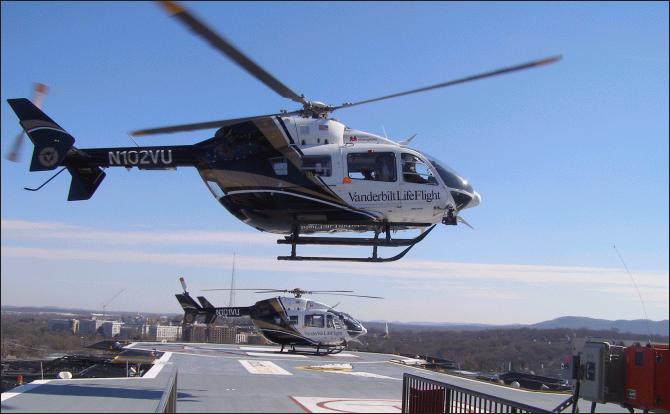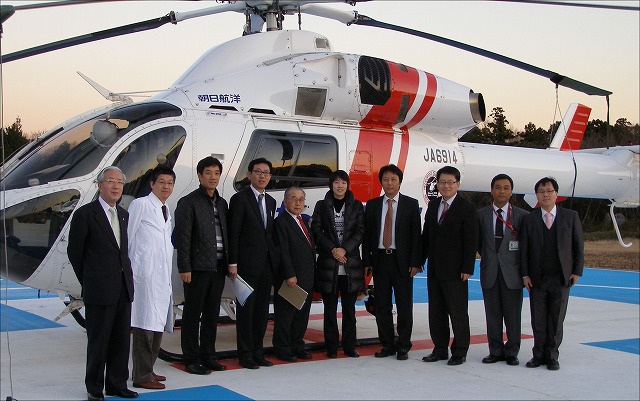<延世大学>
トラウマ・シンポジウム講演抄録 去る12月17日、韓国の原州(ウォンジュ)にある延世大学医学部で開催されたトラウマ・シンポジウムでの講演抄録。例によって山野豊氏に英訳していただいた。そのもとになった拙文は本頁後半にある。
韓国ではまだヘリコプター救急がおこなわれていないので、話の内容も基本的なことにとどめてある。

Abstract - International Overview of HEMS System Experience of transporting injured soldiers in a battlefield was the mother of today's helicopter emergency medical service (HEMS). As a result of having used helicopters extensively in particular in jungle where no road was prepared in the Vietnam War, the lifesaving rate of the injury soldiers compared with former war rose by double.
In the U.S.A., the experience in Vietnam War was made a good example for used in the Domestic Traffic War. It was from 1970's that a dedicated helicopter became a tool for HEMS. Nowadays about 900 dedicated helicopters are in service and 731 heliports have been used for HEMS.
Around the same time, the number of traffic accident fatalities increased sharply because of the motorization boom in Germany, and ADAC started operation of helicopter medical emergency service from November 1970 in Munich. As a result, the number of traffic death of 21,332 recorded in 1970 was reduced to a half of 10,070 in 1985, 15 years later, and further reduced to 7,509 after another 15 years, which is one-third of the number in 1970.
At this current year, celebration for the 40th anniversary took place in Germany, and 72 bases for HEMS operation are in service. Average number of missions carried out at one base is about 1,350 times a year.
A standard calling for the start of medical treatment in less than 15 minutes sustains high rate of lifesaving effect in Germany. Swiss Air Rescue REGA similarly has established a medical emergency system that is feasible to deliver a doctor within 15 minutes to any place where a patient is although it is mountainous country. REGA has arranged helicopters to cover any place such as top of mountains and bottom of deep valley in a reach of 15-minute timeframe.
In Britain, 26 air bases for helicopter emergency medical service have been arranged in the whole country. HEMS system in London is so exemplary that a helicopter based on the rooftop helipad of the Royal London Hospital can fly freely above the center of London and achieved successful operation for life saving mission.
London HEMS can land nearby a patient on a congested street thanks to the support two pilots on board, in-depth understanding of the emergency rescue center to the helicopter operation, collaboration of the road security police, air traffic controller who gives top priority the flight for emergency medical service and understanding and cooperation of invisible citizens.
A considerably large amount of fund will be necessary to manage the system as mentioned above.
Who bears the cost? It is important that no charge will be made to a patient but a private medical insurance in the U.S. will bear the charge and a health insurance in Germany will bear the charge in Germany. Major fiscal resources are from people's contribution and medical insurance in Switzerland and a lot of parts relies on the contribution Britain. And, France and Japan depend on public expense of the government.
The management system and the defrayal for the HEMS operation will be designed flexibly to meet national circumstances. However, there is one common essential requirement in any country for HEMS. It can be said how to save a life that falls into crisis.
ヘリコプター救急の始まりは戦場における負傷兵の救護の経験であった。特にベトナム戦争では道のないジャングルの中で本格的にヘリコプターを使った結果、負傷兵の救命率が以前の戦争にくらべて2倍以上に高まった。そのことから、アメリカでは、この経験を国内の交通戦争に使うこととなり、1970年代から専用のヘリコプターによって日常的に救急業務がおこなわれるようになった。
今では全米731ヵ所にヘリコプター救急拠点が設けられ、およそ900機が飛んでいる。
同じ頃、ドイツでも自動車ブームのために交通事故の死者が急増した。これに応じてドイツ自動車クラブADACが1970年11月からミュンヘンでヘリコプター救急飛行を開始する。その結果、交通事故によるドイツの死者は1970年の21,332人から、15年後の1985年には10、070人に半減し、さらに15年たった2000年には7,503人とほぼ3分の1に減った。
発足40周年を迎えた現在、ドイツの救急拠点は72ヵ所となり、1ヵ所平均して年間1,350件の出動をしている。
ドイツの救命効果が高いのは15分以内の治療開始という基準が定められていることによるが、同じようにスイスもアルプス山岳国でありながら、国内どこでも、15分以内に医師を患者のそばへ送り届ける救急体制をとっている。これがスイス・エア・レスキューREEGAで、高い山の上でも深い谷底でも15分以内に到達できるようにヘリコプターを配備している。
イギリスには全国26ヵ所にヘリコプター救急拠点が存在するが、とりわけロンドンのそれは模範的で、市内中心部のロイヤル・ロンドン・ホスピタルを拠点とし、大都会の中を自由に飛び回って救命効果を挙げている。
ロンドンHEMSが、混雑した道路で救急患者のすぐそばに安全に着陸できるのは、パイロットが2人乗務というだけでなく、救急センターのヘリコプターに対する深い理解と、道路の警護にあたる警察の協力、救急飛行を最優先とする航空管制、さらには目に見えない市民の協力があるからだ。
以上のようなヘリコプター救急体制を運営してゆくには、当然のことながら、かなりの費用がかかる。その費用を誰が負担するか。基本的には患者の負担としないことが重要だが、そのうえでアメリカの場合は民間の医療保険から支払われ、ドイツでは健康保険で支払われる。またスイスは国民の寄附と医療保険が主な財源であり、イギリスは寄附に頼る部分が多い。そしてフランスと日本は政府の公的な出費による。
救急ヘリコプターの運営システムや費用負担は、それぞれの国の実情に応じて、さまざまな制度設計が可能である。しかし、どの国にも共通するのは、危機におちいった人命を如何にして救うかという一点といえよう。
(西川 渉、2011.1.4)
韓国から戻ったわれわれを追うようにして、2010年12月27日
現地でお世話になった李康賢教授(Dr. Kang Hyun Lee)を初め、
救急医や韓国厚生省の担当官(いずれも医師)など合わせて6人が来日、
千葉北総病院を訪ねて実際のドクターヘリを視察した。(表紙へ戻る)



